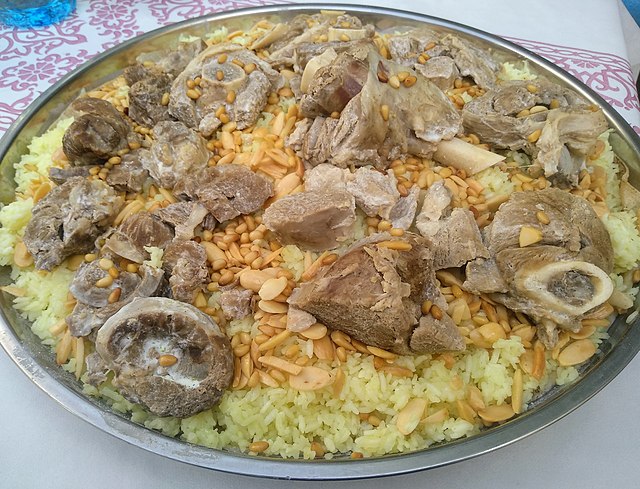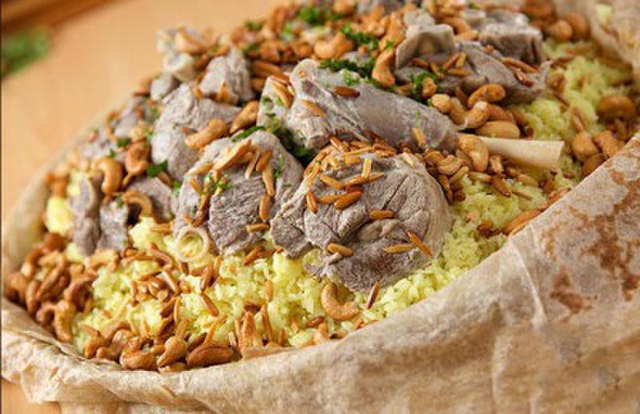Mansaf: The Pride of Jordanian Cuisine
By: Habeeb Salloum/Arab America Contributing Writer

The first time I sat down to a feast featuring mansaf was in the countryside near Amman, the capital of Jordan. Surrounded by distinguished-looking men in flowing Arab robes, I reclined quietly beside my host around a steaming platter of rice covered with lamb and nuts. The conversation was almost zilch as we gorged ourselves on tender and succulent meat served over steaming rice, made even tastier by the yogurt and spices.
Being an honoured guest, my host picked out for me the choicest pieces of meat as he urged me on. In the best tradition of Arab hospitality he made sure that I was overfed. Of course, I did not need much encouragement. Every mouthful of the appetizing food made me crave for more. It was a feast that I have always remembered.
In Jordan mansaf, the pride of Jordanian cuisine and the national dish of the country is usually prepared for and served to esteemed guests primarily on special occasions such as weddings, birthdays, and anniversaries. The dish possesses an important symbolic function within social gatherings, it being offered as the ultimate to the honoured guest. The daily family food of the people is often not as sumptuous but healthier – much of it relating to earlier times when most of the inhabitants of today’s Jordan were poor Bedouins, peppered with a few peasants.
Mansaf stands as the ultimate of Jordanian cuisine – a part of Arab gastronomy, which is one of the world’s most sophisticated and elaborate cuisines. Jordanian food, although having some unique attributes, is part of this Middle Eastern distinctive culinary heritage, but stemming more from traditional Bedouin cooking
A mansaf feast is taken seriously, and hours are spent in its preparations. A dish of lamb seasoned with herbs and spices, it is served on a large platter on a bed of rice in a tangy yogurt sauce and sprinkled with almonds and pine nuts. Traditionally, the yogurt used is jameed, a type of salted dried goat milk.
The main course of a mansaf meal usually begins with several varieties of mazza, or hors d’oeuvres and with several salads as side dishes. Bread, usually khoubz sh’rak, a large thin, round unleavened bread, accompanies every meal and a dessert or fresh fruit ends a meal. Lastly, comes the famous Arabic coffee without which no meal is complete.
Mansaf

Serves 10 to 12
Traditionally eaten from a communal dish using the right hand, mansaf is today also available in restaurants. However, if there are guests they are offered forks and knives. Also, since jameed is hard to find outside of Jordan, yogurt is a fine substitute.
3 cups plain yogurt, thoroughly mixed with one cup water
1 egg white, beaten with a fork until frothy
2 tablespoons cornstarch
3 teaspoons salt
6 pounds lamb with bones, washed and drained then cut into serving pieces
1 1/2 teaspoons black pepper
1/2 cup butter
1/2 cup pine nuts
1/2 cup almonds
1 large onion, chopped
1 teaspoon turmeric
1 teaspoon allspice
1/2 teaspoon cinnamon
3 cups rice, rinsed
6 cups water
2 large loaves of Arabic bread, toasted and broken into pieces
Place yogurt in a pot and stir in egg white, cornstarch and 1 teaspoon of the salt, then stirring continually with a wooden spoon in one direction (very important to stir in one direction) bring to boil over medium heat. Lower heat to low then allow to boil uncovered until yogurt thickens about 3 minutes, continuing to stir. Set aside but keep warm.
Place lamb in a large pot and cover with water then bring to boil over medium heat, skimming off froth repeatedly until boiling. Add remaining salt and pepper. Cover and cook over medium heat for 30 minutes.
In the meantime, melt 4 tablespoons of the butter in a frying pan and sauté almonds and pine nuts until they just begin to brown then pour on to a plate, draining butter back into the frying pan.
Add onion to frying pan and fry over medium heat for 8 minutes, adding more butter if necessary. Stir in turmeric, allspice and cinnamon then stir-fry for further 2 minutes. Add this mixture to the boiling meat.
While the meat is cooking, place the rice and water in a large saucepan then bring to boil. Turn heat to low and cover then cook for 20 minutes, stirring a number of times and recovering. Turn off heat but leave covered and allow to cook in its own steam for another 30 minutes. Stir in remaining butter and keep warm.
After meat has been cooking for 1 1/2 hours remove lid and stir in yogurt sauce. Turn heat to low and cook until meat is tender and sauce thickens. Remove meat and set aside, keeping warm. Pour sauce into a bowl and keep warm.
On a large platter, place bread then moisten with some of the sauce. Place rice pyramid style over the bread then place meat evenly over rice. Spoon some of the sauce over top then sprinkle with the nuts and serve. Each diner can add from the leftover sauce to taste.


